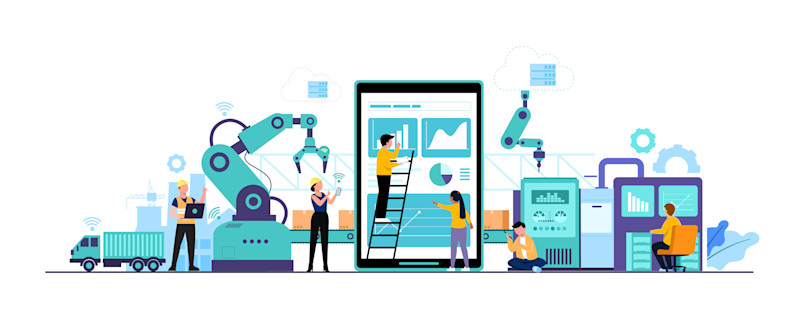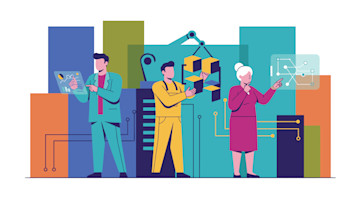TECHNOLOGY
Who Cares About Material Science Innovation?
Several industries are leading the charge to innovate new materials. These materials are harder, more thermally resistant, corrosion-resistant, and more abrasion-resistant. OEMs benefit from these materials, which enable lighter, more efficient designs, increased power, and better reliability.
As a result, manufacturers will be tasked with processing these materials faster throughout the entire manufacturing ecosystem. The underlying question they will face is: Do I have the confidence and speed needed to do it correctly? By the time the drawing package and raw material arrive at tier-three suppliers for refining, there is not much time to iterate on their manufacturing process to achieve a stable process. Manufacturers will need a reliable starting point for forming, welding, material removal, and additive manufacturing. The need for a technical manufacturing dataset to support the physical raw material will grow to aid in de-risking new materials.
INTELLIGENCE
The Economics of Automation
Automation is emerging as a crucial solution to the manufacturing industry's workforce challenges. As skilled workers become scarce and expensive, companies are turning to automation to fill the gap.
The aging workforce, coupled with younger generations' preference for workplace flexibility, is driving this trend. Automation not only addresses labor shortages but also boosts productivity and profitability. Top-performing shops utilizing automation achieve higher capacity utilization and profit margins compared to their peers.
While historically limited to large companies, advancements in technology have made automation more accessible to smaller operations. As the industry faces potential shortages of up to 3.8 million jobs between 2024 and 2033, automation offers a way to attract younger workers and retain existing talent by providing opportunities for skill development in future-oriented roles.
SMARTFORCE
Smartforce Outlook: Shaping the Future Workforce With AI
Artificial intelligence is transforming the skills gap challenge in manufacturing into an opportunity for growth. Advanced AI-powered training tools and simulations provide hands-on learning experiences, making it easier for workers to gain practical skills remotely or on the job. Educational programs now integrate AI technology to offer personalized learning paths, ensuring that students and professionals gain the competencies most in demand. AI is also reshaping roles within manufacturing, shifting the focus from repetitive tasks to higher-value, tech-centric roles like programming, system integration, and data analysis. As AI enhances these training tools and education opportunities, it equips the workforce with the skills needed to thrive in a more automated and interconnected manufacturing environment, bridging the gap more effectively than ever before.
INTERNATIONAL
Data Drives Efficiency and Resilience
Manufacturing has long stood out as the leading sector in terms of data generation. Utilizing this digital gold mine is crucial for a healthy outlook in global manufacturing.
For years, the industry eagerly anticipated the potential of digital twin technology for predictive maintenance and performance monitoring. Today, this technology has become almost fundamental to modern manufacturing plant management by reducing maintenance costs, decreasing downtime, and increasing overall equipment effectiveness.
Supply chain restructuring is another significant trend in the global manufacturing landscape, driven by the need to reduce risk and increase resilience. By adopting and implementing digital tools to improve visibility and traceability across the entire value chain, manufacturers can reduce dependence on single suppliers or geographic regions.
The key, in both cases, of course is the data. Without it, there is nothing but empty promise.
ADVOCACY
Are Major Tax Increases on the Horizon?
The Department of Commerce’s Bureau of Industry and Security introduced new global export controls on four advanced technologies:
Additive Manufacturing Items
Advanced Semiconductor Manufacturing Equipment
Quantum Computing Items
Gate-All-Around Field-Effect Transistor Technology
Exports that fall under these categories to countries participating in the Wassenaar Arrangement are generally presumed to be approved, with the exceptions of Malta, Russia, and Ukraine. Conversely, exports to nations deemed a national security concern, such as Albania, Armenia, Belarus, Cambodia, Cuba, China, Iraq, North Korea, and Russia, are typically denied. For further details, please visit BIS.gov.
The U.S. Environmental Protection Agency issued a direct final rule postponing the reporting period for per- and polyfluoroalkyl substances (PFAS) under the Toxic Substances Control Act to July 11, 2025. The extension shifts the original start date from Nov. 12, 2024. Companies required to report PFAS data now have until Jan. 22, 2026, to fulfill their obligations. For additional information, visit epa.gov.






